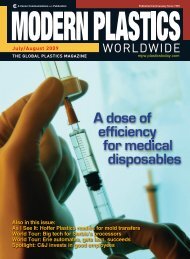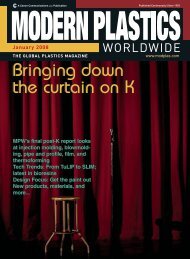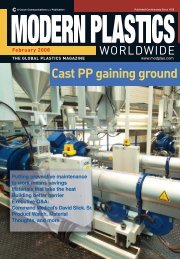amidiq - dae uptlax
amidiq - dae uptlax
amidiq - dae uptlax
You also want an ePaper? Increase the reach of your titles
YUMPU automatically turns print PDFs into web optimized ePapers that Google loves.
N. Balagurusamy / Revista Mexicana de Ingeniería Química Vol. 6, No. 3 (2007) 237-242<br />
which indicated an efficient extraction of DNA from<br />
the digester slurry. O’Donnel and Görres (1999)<br />
reported that the yield of DNA generally varied<br />
between 2 and 35 mg g –1 dry soil. The A260/280<br />
was1.876, which indicated the high quality of<br />
extracted DNA (Drábková et al., 2002).<br />
The use of molecular biological techniques,<br />
especially those that take advantage of the smallsubunit<br />
(SSU) rRNA molecule, has eliminated the<br />
dependence on isolation of pure cultures as a means<br />
of studying the diversity and structure of microbial<br />
communities (Schramm and Amann, 1999). The<br />
microbial consortia in soil, sediments, anaerobic<br />
digesters and different other systems have been<br />
analyzed using this approach (Godon et al., 1997a;<br />
1997b; O’Donnel and Görres, 1999; Mladenovska et<br />
al., 2003). Most of the ecosystems are open-field<br />
systems, and only one sample was analyzed. Even<br />
with a representative sample, it is difficult to<br />
distinguish between endogenous and transient<br />
microorganisms. Others such as anaerobic reactors<br />
are closed systems, but the microorganism’s<br />
analyzed span either a small number of clones or<br />
only one taxon. As little is known about this<br />
ecosystem, a molecular inventory is the first step to<br />
describe these dynamic microbial communities<br />
without cultivation.<br />
In this study, different PCR conditions for<br />
amplification were tested and PCR amplicon (566<br />
bp) obtained under optimum conditions was inserted<br />
in TOPO vector, transformed into chemically<br />
competent Escherichia coli and the clones were<br />
selected by resistance for ampicillin. From the clone<br />
library, ten clones were picked and multiplied in LB<br />
broth at 37ºC for overnight. Simultaneously the<br />
clones were also dot streaked in LB agar with<br />
ampicillin using sterile tooth picks to preserve the<br />
clones for further studies. The plasmid DNA (3.9 kb)<br />
of the clones grown in LB broth was isolated and<br />
checked for their purity (Fig. 1). The isolated<br />
Plasmid DNAs were amplified using 341F primer<br />
(45 cycles) and sequenced with ABI BigDye ®<br />
Terminator v3.1 cycle sequencing kits. Sequences of<br />
the clones were compared with database in RDP and<br />
a phylogenetic tree was constructed by ClustalW<br />
analysis (Fig. 2) and the distance of the clones based<br />
on similarity percent is presented in Fig. 3. In the<br />
present study sequence analysis showed that the<br />
majority of the clones pertained to uncultured<br />
clostridia.<br />
Buzzini et al. (2006) observed that structure of<br />
the microbial community in an anaerobic digester is<br />
complex and most of the population belonging to the<br />
domain Bacteria remained stable through the<br />
process, but was sensitive to operational changes.<br />
Earlier, Godon et al. (1997a) reported that the<br />
presence of more than 146 different organisms<br />
belonging to the three domains Bacteria, Eucarya,<br />
and Archaea in an anaerobic digester. Among the<br />
139 OTUs (Operational Taxonomic Unit) recorded,<br />
133 were from the Bacteria domain. These<br />
observations indicated that there is rich diversity of<br />
bacteria in an anaerobic digester, many of which are<br />
not yet identified. However, in this study the<br />
eubacterial species diversity was less and further<br />
they pertained to uncultured bacterial groups. In<br />
accordance, Tauber et al. (2007) reported that the<br />
species diversity of bacteria was less in thermophilic<br />
anaerobic digester. Apajalahti et al. (2004) reported<br />
that 90% of the bacteria in the chicken<br />
gastrointestinal tract represented previously<br />
unknown species and this could be related to the<br />
higher presence of unidentified bacteria in this study,<br />
as the digester is fed with poultry litter. Earlier,<br />
Godon et al. (1997b) also observed that the most<br />
frequent bacterial OTU in an anaerobic digester were<br />
less than 5% of the characterized bacterial population<br />
and the majority of them were not closely related to<br />
other hitherto-determined sequences.<br />
The results of this study also showed that the<br />
clostridia were predominant among the clones. This<br />
could be related to the nature of the poultry waste,<br />
which contained high cellulose (20% on dry basis)<br />
and hemicellulose (11% on dry basis) content<br />
(Espinosa-Solares et al., 2006) and it is widely<br />
known that cellulose hydrolysis is the rate-limiting<br />
step in the anaerobic digestion of organic solid<br />
wastes (O'Sullivan et al., 2005).<br />
Fig. 1. Plasmid profile of the clones.<br />
239









